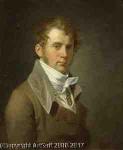John Vanderlyn
John Vanderlyn
Style: Neo-Classicism;
Place: Kingston
Born: 1775
Death: 1852
Biography:
John Vanderlyn was an American neoclassicist painter, born on October 15, 1775, in Kingston, New York. He was the grandson of colonial portrait painter Pieter Vanderlyn. Vanderlyn's artistic career was shaped by his early experiences, including his employment by a print-seller in New York and his instruction in art by Archibald Robinson, a Scotsman who later became one of the directors of the American Academy of the Fine Arts.
Early Career and Training
Vanderlyn's early training included copying portraits by Gilbert Stuart, a prominent American portrait painter. He also spent time in the studio of Stuart, where he developed his skills in portraiture. In 1796, Vanderlyn was sent to Paris by Aaron Burr, where he studied for five years. This period in Paris had a significant impact on Vanderlyn's artistic style, as he was exposed to the works of French neoclassicist painters.
Notable Works and Achievements
Vanderlyn's notable works include The Landing of Columbus, which was commissioned by Congress in 1842. This painting is now housed at the United States Capitol. He also painted portraits of prominent figures, such as James Monroe, John C. Calhoun, and George Washington. Vanderlyn's work can be found in various museums, including the Worcester Art Museum and the Birmingham Museum of Art.
- Neoclassicism: Vanderlyn's artistic style was characterized by its adherence to neoclassicist principles, which emphasized the use of classical forms and themes.
- Portraiture: Vanderlyn was a skilled portrait painter, and his works include many notable examples of this genre.
- Historical Paintings: Vanderlyn's paintings often depicted historical events and figures, demonstrating his interest in recording and interpreting the past.
Legacy and Influence
Vanderlyn's legacy as a neoclassicist painter is evident in his contributions to the development of American art. His work can be seen in the context of the Neo-Classicism movement, which sought to revive classical forms and themes in art. Vanderlyn's paintings are now housed in various museums, including the New York Historical Society and the Wadsworth Athenaeum. For more information on Vanderlyn's life and work, visit John Vanderlyn's page on Wikioo.org or his Wikipedia page. You can also explore Wikioo.org's collection of oil paintings reproductions and museum reproductions to learn more about the artist and his contemporaries.
Wikipedia link: Click Here














